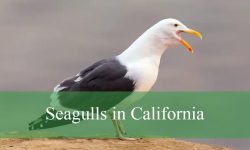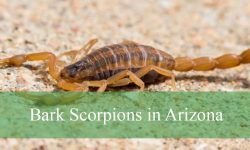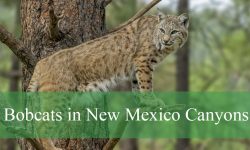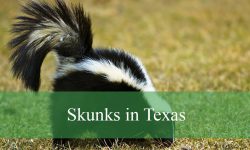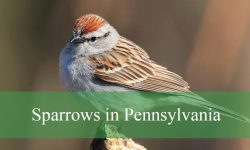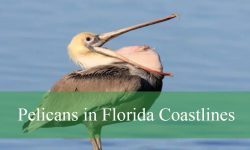One of the most magical moments I’ve had in Washington was standing quietly in my garden when a tiny flash of emerald and ruby zipped past my face. It hovered so close I could hear the rapid hum of its wings before darting off to the flowers. That was the day I truly fell in love with hummingbirds.
Since then, I’ve spent countless mornings watching these energetic little birds at feeders, in mountain meadows, and along coastal gardens. Washington is lucky to host several species of hummingbirds, each with unique colors, behaviors, and seasonal patterns. Let’s explore the eight species you might encounter here, with pictures and identification tips to help you spot them.
Types of Hummingbirds Found in Washington State
Anna’s Hummingbird
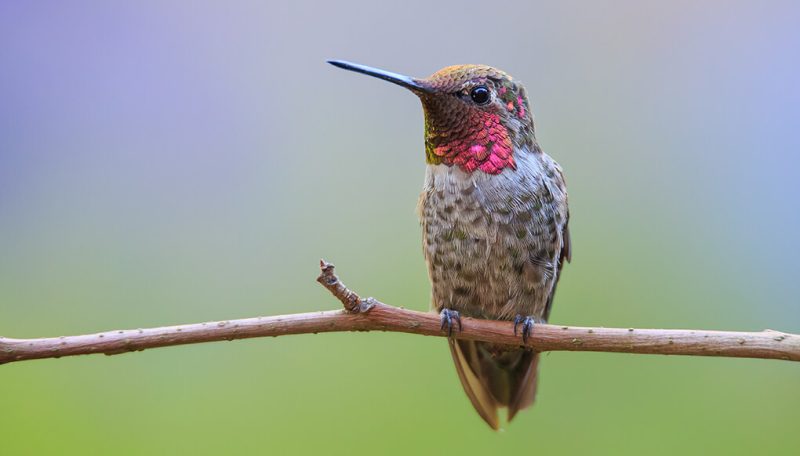
Anna’s Hummingbirds are medium-sized hummingbirds with a stocky build, measuring about 4 inches in length with a wingspan of 4.5 inches. Males are especially striking, with an iridescent emerald green back and crown, and a brilliant rose-pink throat that glistens in sunlight. Females are slightly duller, with green backs and grayish-white underparts, and may have some pink on the throat, but it is much subtler than in males. Both sexes have a relatively short, straight bill and small tail feathers that are slightly forked.
In terms of behavior, Anna’s Hummingbirds are known for their boldness and territorial nature. Males often perch conspicuously while singing and performing dramatic aerial displays to attract females. These hummingbirds feed on nectar from a variety of flowers, including garden plants, and also consume small insects and spiders for protein. They are adaptable and will visit hummingbird feeders frequently, especially in urban and suburban areas.
Anna’s Hummingbirds are year-round residents in Washington State, particularly in western regions, including the Puget Sound area. They favor gardens, parks, and open woodlands, often nesting in shrubs or small trees. Their nests are tiny, cup-shaped structures made of plant fibers, moss, and spider silk, which allow them to expand as the chicks grow.
A fun fact about Anna’s Hummingbirds is that males can enter a “shuttle display,” flying vertically in a U-shaped pattern and emitting a rapid, high-pitched trill with tail feathers vibrating to attract mates. Unlike many other hummingbirds in North America, Anna’s Hummingbirds are increasingly seen in urban areas year-round due to the availability of feeders and mild winter conditions in western Washington.
Rufous Hummingbird
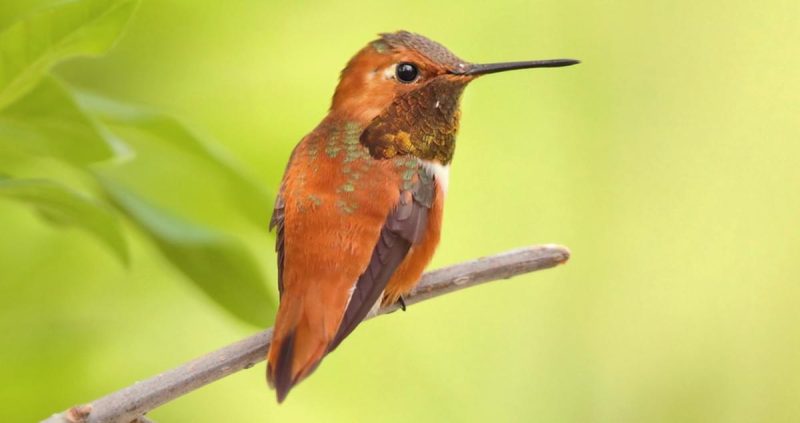
Rufous Hummingbirds are small but feisty, measuring about 3 to 3.5 inches in length with a wingspan around 4 inches. Males are known for their striking reddish-orange plumage on the back and flanks, with a bright, iridescent red throat. Females and immature males are greener on the back with pale underparts and reddish patches on the sides of the throat, making them more cryptic but still recognizable. Their tail feathers are slightly notched, and they have a medium-length, straight bill suited for probing flowers.
These hummingbirds are extremely aggressive and territorial, often chasing off birds much larger than themselves. Rufous Hummingbirds feed primarily on nectar, favoring tubular flowers such as columbine, penstemon, and flowering shrubs, and supplement their diet with small insects and spiders. They are also regular visitors to backyard feeders and are known to dominate them, often displacing other hummingbird species.
Rufous Hummingbirds breed primarily in the Pacific Northwest, including eastern and western Washington, favoring open forests, meadows, and shrubby habitats. They are migratory, arriving in Washington in spring and leaving for wintering grounds in Mexico by late summer or early fall. They build tiny cup-shaped nests on branches or tree forks, camouflaged with lichens and mosses.
A fascinating fact about Rufous Hummingbirds is their extraordinary migratory behavior: they make one of the longest migrations relative to body size of any bird, traveling up to 3,900 miles round-trip. Despite their small size, they are extremely resilient, enduring long flights across the Rocky Mountains and the Gulf of Mexico. Their fiery temperament and striking color make them a favorite among birdwatchers in Washington State.
Allen’s Hummingbird
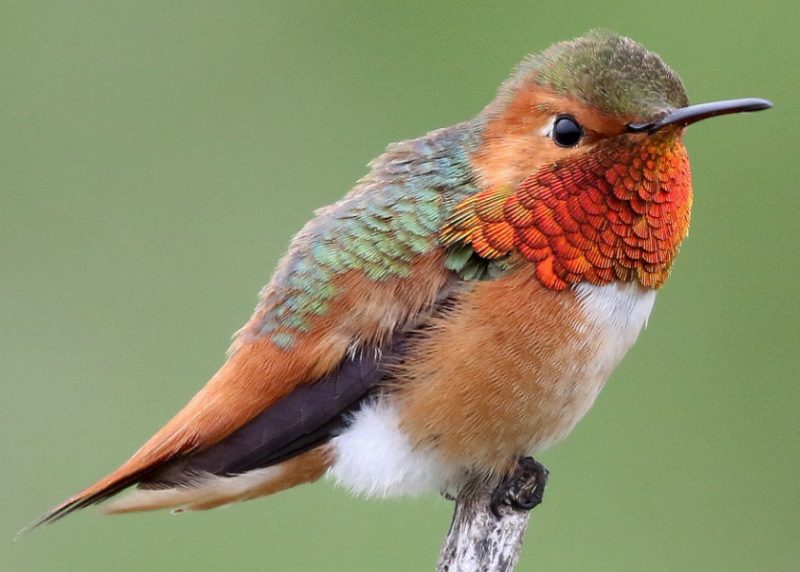
Allen’s Hummingbirds are slightly smaller than Anna’s, measuring about 3.5 inches in length with a wingspan of 4 inches. Males feature an iridescent green back and crown with a vivid orange-red throat and chest, while females are green above with grayish underparts and some orange spotting on the sides of the throat. The tail is rounded, with males showing rufous-colored outer tail feathers that aid in identification. They have a straight, slender bill perfect for nectar foraging.
Behaviorally, Allen’s Hummingbirds are energetic and highly territorial during breeding season. Males perform intricate flight displays, including rapid dives and shuttling motions, to court females. They feed on nectar from native flowers such as fuchsia, columbine, and manzanita, while also consuming small arthropods to meet their protein needs. These hummingbirds readily use backyard feeders, but they can be aggressive toward other hummingbird species.
In Washington State, Allen’s Hummingbirds are less common than Anna’s and Rufous, primarily seen along coastal and southern areas during migration. They prefer open woodlands, gardens, and areas with abundant flowering plants for feeding and nesting. Their nests are tiny cups made from plant fibers, down, and spider silk, often camouflaged with lichens on tree branches or shrubs.
A fun fact about Allen’s Hummingbirds is that males may establish and defend multiple territories within a small area to maximize mating opportunities. Unlike the Rufous, their range in Washington is more limited, but birders may observe them alongside other hummingbird species in gardens and coastal meadows during migration. Their brilliant coloration and energetic behavior make them a striking sight.
Calliope Hummingbird
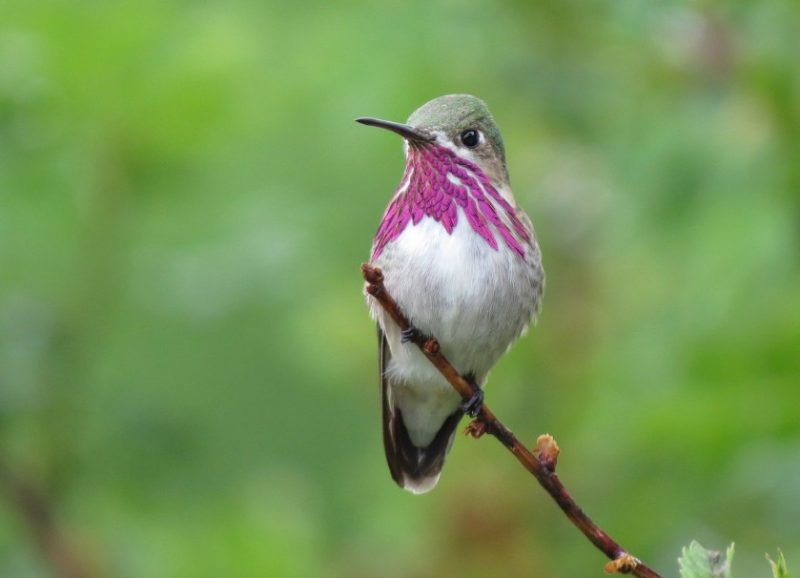
Calliope Hummingbirds are the smallest breeding hummingbirds in the United States, measuring only 3 inches in length with a wingspan of about 4 inches. Males are easily recognized by their iridescent magenta throat spines, which form a striking gorget against a green back. Females are subtler, with green upperparts, grayish-white underparts, and faint streaks on the throat. Their tails are slightly forked, and their bill is short and straight, ideal for feeding on nectar.
These hummingbirds are agile and quick, exhibiting darting flight patterns as they forage. They feed on nectar from flowers such as penstemon, monkeyflower, and currant, supplemented by small insects and spiders. Calliope Hummingbirds are less aggressive than Rufous or Anna’s but can still chase competitors from feeding territories. They are highly active, hovering rapidly while probing flowers and maneuvering skillfully between branches.
Calliope Hummingbirds breed in higher elevation habitats in eastern and central Washington, favoring open coniferous forests, mountain meadows, and riparian zones. They migrate to wintering grounds in southern Mexico, making their spring and fall passages a highlight for birdwatchers in the state. Their nests are tiny, camouflaged cups woven from plant fibers and spider silk, often hidden in shrubs or small trees.
A fun fact about Calliope Hummingbirds is their impressive courtship dive: males perform a series of U-shaped dives, producing a high-pitched, buzzing sound with their tail feathers to attract females. Despite being the smallest hummingbird in the U.S., they are tenacious and resilient, thriving in mountainous and open habitats of Washington State, often at higher elevations than other local hummingbird species.
Black-chinned Hummingbird
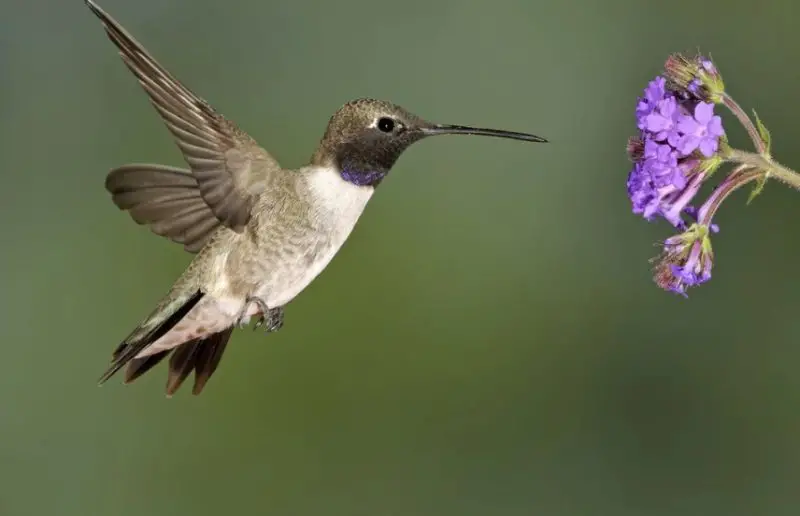
Black-chinned Hummingbirds are medium-sized, about 3.25–4 inches long with a wingspan of roughly 4 inches. Males have a distinctive black throat with a thin violet base and metallic green upperparts, while females are grayish-white below with green backs and a faintly streaked throat. Their tails are slightly forked with dark feathers tipped in white, and they have a straight, slender bill for feeding on nectar.
Behaviorally, Black-chinned Hummingbirds are territorial and bold during the breeding season. Males perform rapid “shuttle displays,” flying back and forth to attract females while producing buzzing sounds. They feed primarily on nectar from tubular flowers, including penstemon, columbine, and currant, and supplement their diet with tiny insects and spiders. They are adaptable and will use feeders if available, often defending them aggressively.
In Washington State, Black-chinned Hummingbirds are considered uncommon and mostly appear during migration in late spring or early fall. They are usually found in open woodlands, shrublands, and gardens with abundant flowering plants. Their nests are small cups built from plant fibers, moss, and spider silk, typically placed on slender branches or shrubs.
A fun fact is that Black-chinned Hummingbirds can hover for extended periods while feeding or courting, showing remarkable agility. While not as common as Anna’s or Rufous Hummingbirds in Washington, their sleek appearance and audacious behavior make them a treat for birdwatchers during migration periods.
Broad-tailed Hummingbird
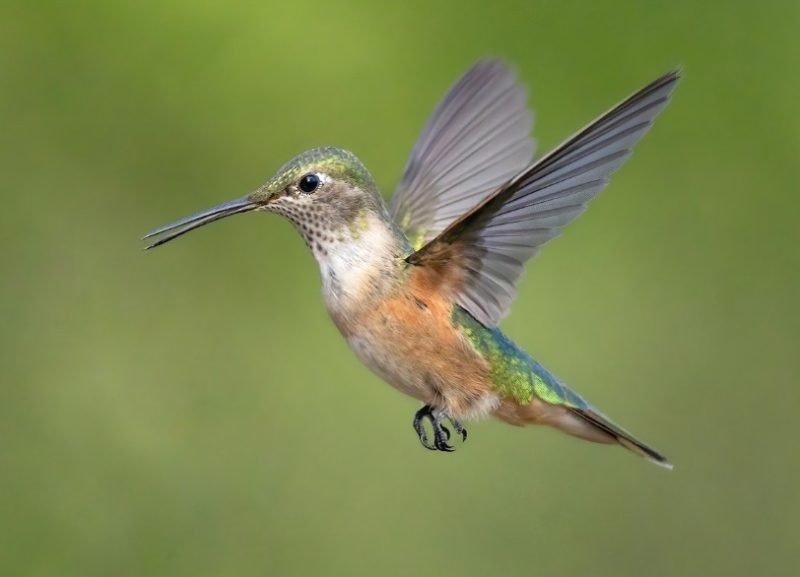
Broad-tailed Hummingbirds are small, about 3.5–4 inches in length with a wingspan around 4 inches. Males are recognized by their iridescent rose-pink throat, green back, and flanks, while females have green upperparts, pale underparts, and faint streaking on the throat. Both sexes have broad tails with slightly notched ends, and their bills are medium-length and straight for efficient nectar feeding.
These hummingbirds are energetic and territorial during the breeding season. Males perform dramatic aerial displays, including U-shaped dives, accompanied by tail-generated buzzing sounds. They feed on nectar from a wide variety of flowers such as columbine, penstemon, and lupine, and consume small insects for protein. They also readily visit backyard feeders in suitable habitats.
Broad-tailed Hummingbirds breed in the mountainous regions of eastern Washington, including open forests, meadows, and riparian zones. They migrate to Mexico for the winter, making them a seasonal presence in the state. Their nests are tiny, cup-shaped, and camouflaged with lichens and mosses on small trees or shrubs.
A fun fact is that males produce a distinctive “buzzing” sound with their tail feathers during courtship dives, a unique acoustic display among hummingbirds. Broad-tailed Hummingbirds are admired for their striking throat coloration and agile flight, especially in high-elevation meadows where they are most commonly found in Washington State.
Broad-billed Hummingbird
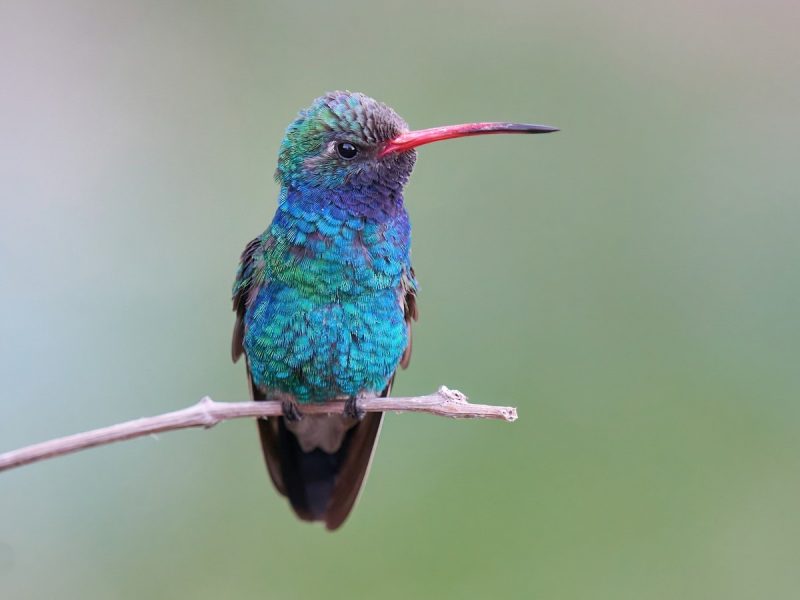
Broad-billed Hummingbirds are slightly larger than many other North American hummingbirds, measuring about 3.25–3.5 inches with a wingspan of around 4 inches. Males are remarkable for their iridescent turquoise throat and bright red bill with a black tip, while females are green above with pale underparts and subtle throat markings. Their tails are moderately forked, aiding in maneuverability during hovering and feeding.
These hummingbirds are highly energetic and primarily feed on nectar from desert and tropical flowers, supplemented with small insects. They are capable of rapid, acrobatic flight, hovering skillfully as they forage. In the wild, they often frequent arid scrublands, but in vagrant instances, they may visit feeders in urban or suburban areas.
In Washington State, Broad-billed Hummingbirds are extremely rare vagrants, typically observed only in fall or winter when individuals wander far from their usual southwestern U.S. range. Their presence is considered unusual and exciting for local birders. Nests are cup-shaped, constructed from plant fibers and spider silk, but sightings in Washington rarely include nesting.
A fun fact is that Broad-billed Hummingbirds can become tame around feeders, allowing close observation of their vivid turquoise throats and brilliant red bills. Their rarity makes them highly sought after by birdwatchers in Washington, adding excitement whenever one appears outside its typical range.
Costa’s Hummingbird
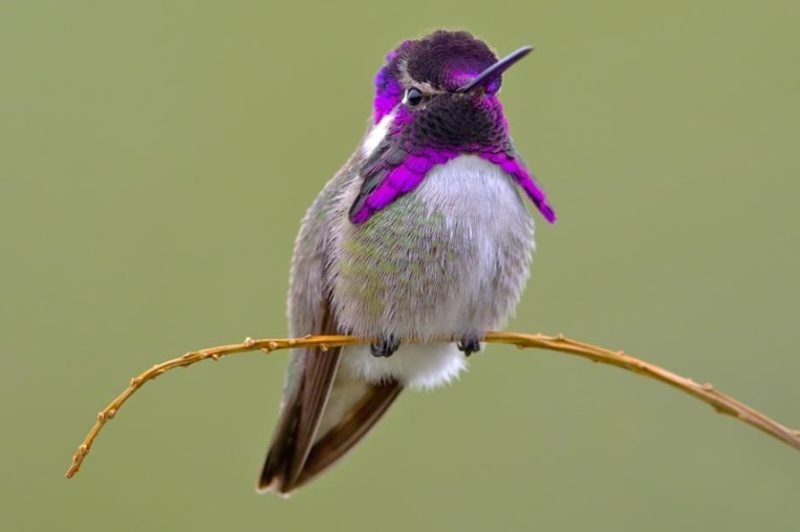
Costa’s Hummingbirds are tiny, measuring about 3–3.25 inches in length with a wingspan of roughly 4 inches. Males are easily identified by their striking violet-purple throat extending up onto the crown, contrasting with green upperparts and grayish underparts. Females are green above with pale underparts and lightly streaked throats. Their slender, slightly curved bill is ideal for nectar feeding.
Costa’s Hummingbirds are fast, agile, and highly energetic feeders. They consume nectar from desert flowers, cacti, and shrubs, supplementing with small insects. Males perform aerial displays, including rapid dives and wing vibrations, to attract females, demonstrating remarkable precision and agility in flight.
In Washington State, Costa’s Hummingbirds are considered very rare vagrants, typically appearing in fall or winter due to wandering outside their normal southwestern range. They do not breed in Washington, and their sightings are exceptional events for birdwatchers. They normally build small cup-shaped nests in desert shrubs, but vagrant individuals are usually solitary visitors.
A fun fact is that Costa’s Hummingbirds are one of the few hummingbirds where the male’s throat feathers extend dramatically onto the crown, creating a hooded, crown-like effect. Their rarity in Washington makes every sighting memorable, and they are often photographed and reported by bird enthusiasts eager to document this unusual visitor.
FAQs About Hummingbirds in Washington State
What hummingbirds are common in Washington?
The most common hummingbirds in Washington are Anna’s Hummingbird, Rufous Hummingbird, and Calliope Hummingbird. Anna’s are year-round residents in western parts of the state, while Rufous and Calliope migrate seasonally. Other species like Black-chinned and Broad-tailed occur less frequently, and Broad-billed or Costa’s are rare vagrants.
When is the best time to see hummingbirds in Washington?
The best time to see hummingbirds in Washington is from spring through late summer, when migratory species like Rufous, Calliope, and Broad-tailed are present. Anna’s Hummingbirds, however, can be seen year-round in many western parts of the state, especially near gardens and feeders.
Do hummingbirds stay in Washington during winter?
Yes, but only Anna’s Hummingbirds are known to remain year-round. They adapt to colder conditions by feeding on backyard feeders, sap wells, and available winter blooms. Migratory species such as Rufous, Calliope, and Broad-tailed leave for warmer regions in Mexico during the winter months.
What should I feed hummingbirds in Washington?
You can feed hummingbirds a sugar-water solution made of four parts water to one part white granulated sugar. Avoid honey, artificial sweeteners, or food coloring, as these can harm the birds. Feeders should be cleaned regularly, especially in warm weather, to prevent mold or bacteria growth.
Where do hummingbirds nest in Washington?
Hummingbirds typically nest in shrubs or small trees, using plant fibers, moss, and spider silk to construct tiny cup-shaped nests. These nests are well-camouflaged with lichens and usually placed on slender branches. Most hummingbird nesting occurs during late spring and early summer in Washington.
Are Rufous Hummingbirds aggressive in Washington?
Yes, Rufous Hummingbirds are known to be highly aggressive and territorial, often chasing away other hummingbirds from feeders and flowers. Despite their small size, they dominate many feeding areas during the breeding and migration seasons.
What is the rarest hummingbird in Washington?
The rarest hummingbirds in Washington are Broad-billed and Costa’s Hummingbirds, which are considered very rare vagrants. They typically stray north from their normal range in the southwestern United States and Mexico, making sightings in Washington exceptional and exciting for birdwatchers.

